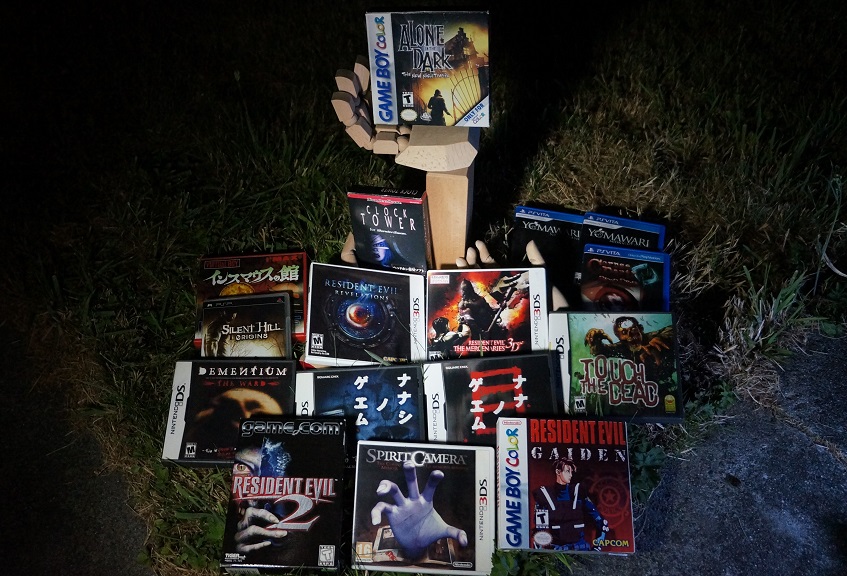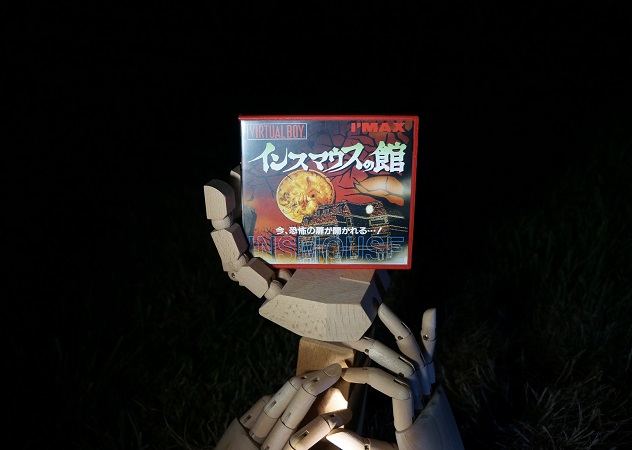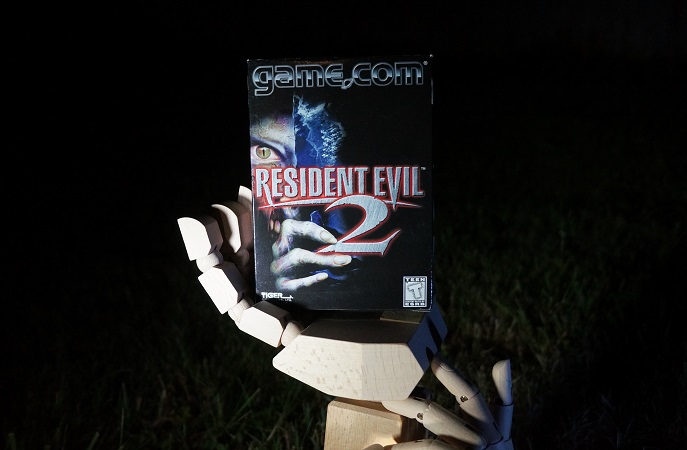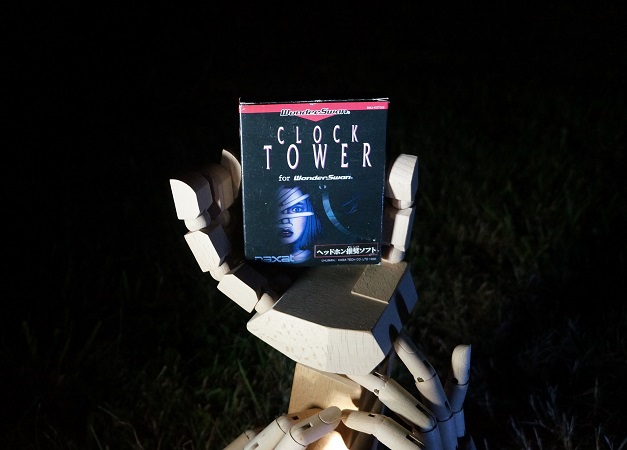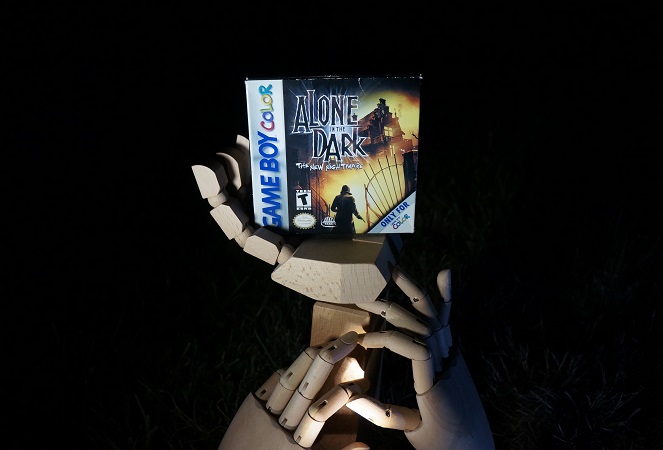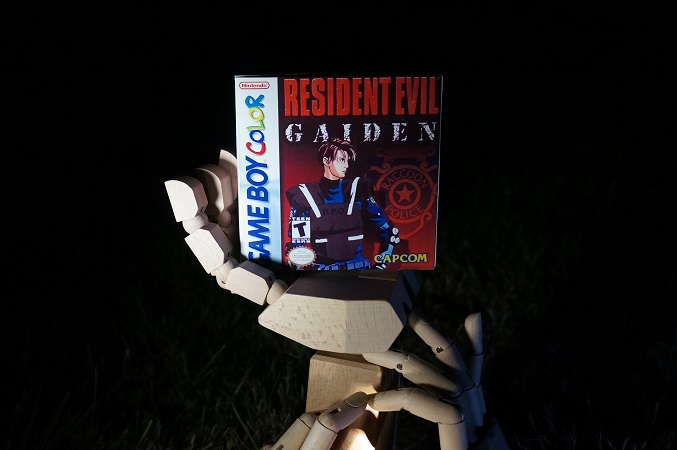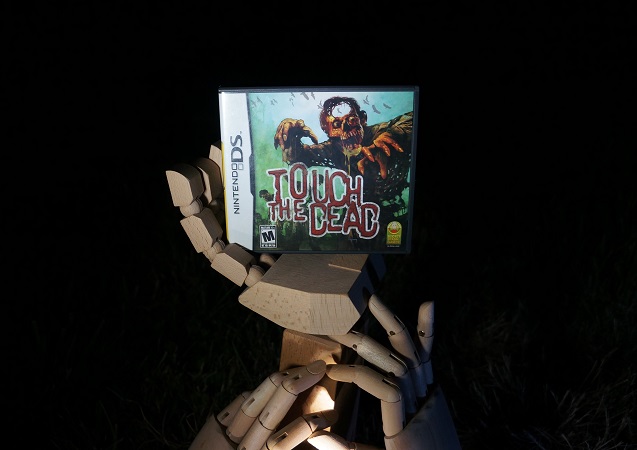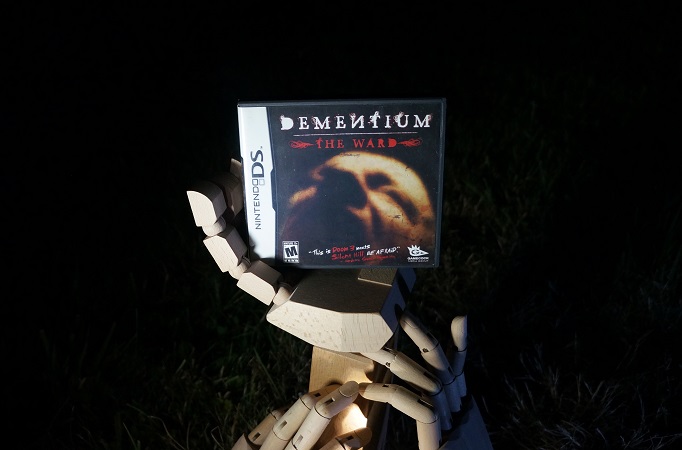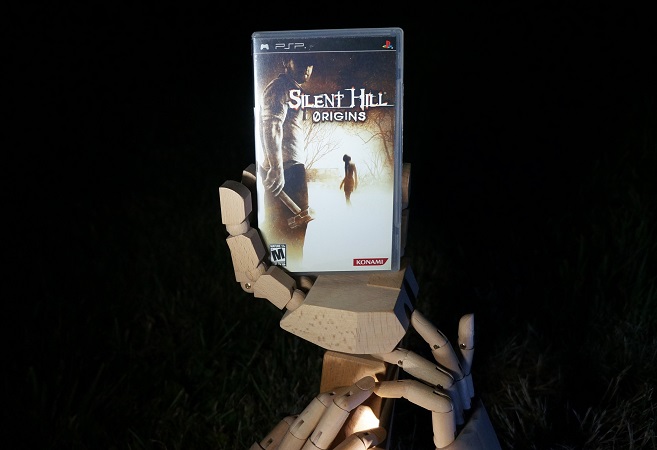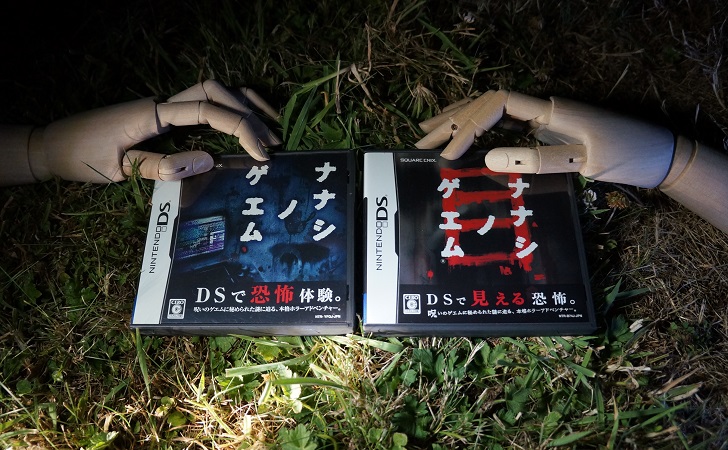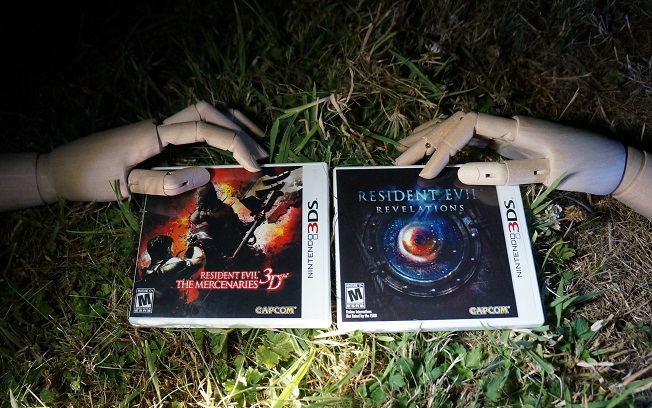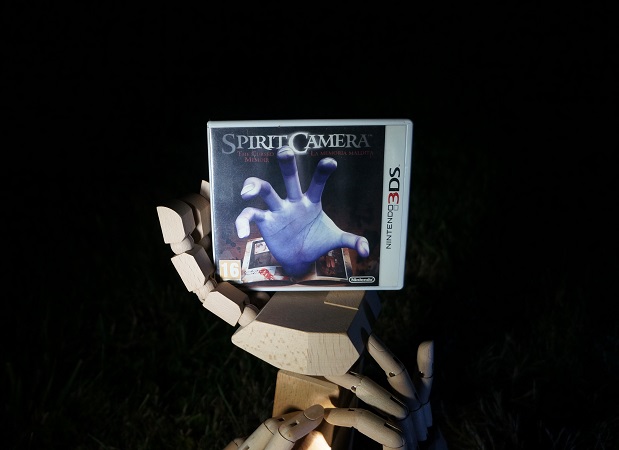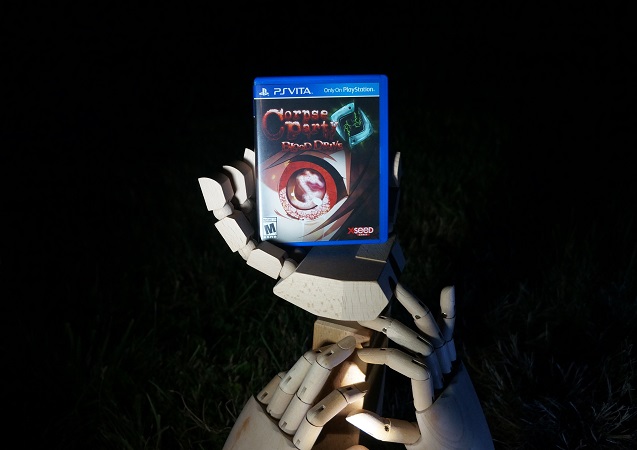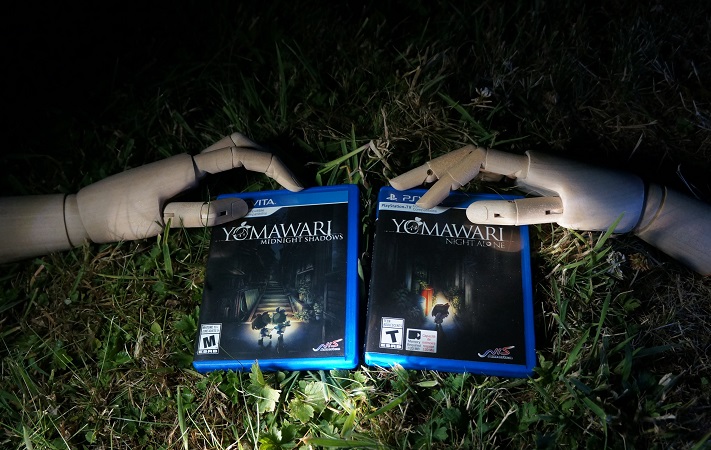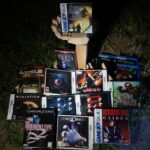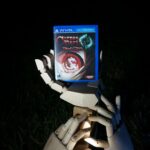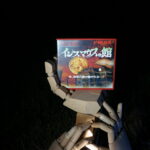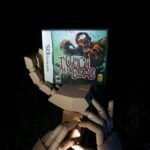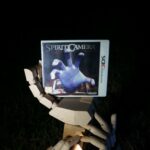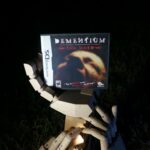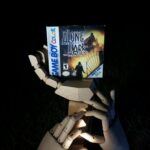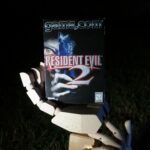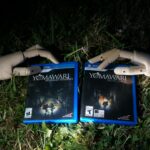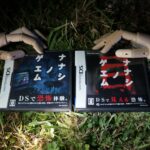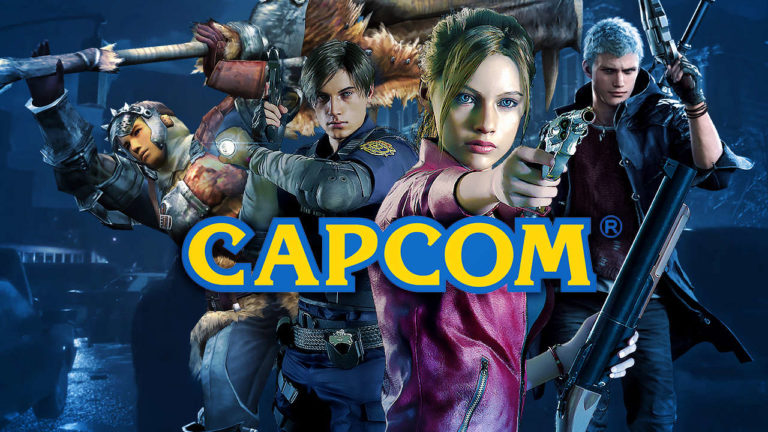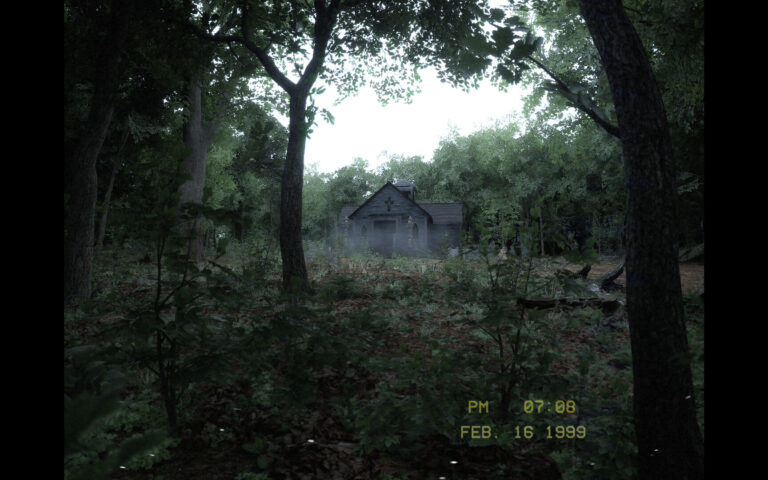Generations of Horror is a series of articles that will journey through the history of console horror gaming by focusing on a certain era or generation of game consoles, discussing some of the most unique, important, or pioneering titles from those periods.
Since its start in the late 1970s, handheld gaming has become a huge segment of the gaming market, with companies like Nintendo garnering a good amount of their business and audience solely based on their handheld consoles, and many others trying to work their way into the market along the way. They’ve been entertaining gamers on the go ever since their inception, however, there’s also been an ongoing debate on how effective the horror genre could really be on handheld consoles, due to the small size of the screen and other potential issues taking away from the immersion of the horror experience.
This argument could easily be refuted, given the fact that handheld consoles have always encouraged players to use headphones to enhance the experience and immersion, which is also true of the horror genre in general, and many would argue that sitting alone with your head buried into a handheld console with headphones in a dark room could be just as effective as any big-screen horror experience.
In recent years, the lines are starting to blur, with things like cloud gaming on cell phones, the Steam Deck, and the Nintendo Switch acting as dual-purpose devices to game on the go and having a much wider library of games to play on the go, but in the history of handheld gaming, games had to be very specifically developed to adjust to the more limited hardware, which led to some quite interesting results and unique experiences compared to many of their home console-based counterparts and contemporaries.
Instead of focusing exclusively on a certain generation for this bonus edition of Generations of Horror, this will be a somewhat brief history of horror games on handheld gaming consoles, instead choosing to highlight innovative or important horror titles that were specifically developed for handheld consoles and not just 1-to-1 ports of a game that already existed on a home console. This will still go in chronological order, based on when the games were released.
*All photos by the author from personal collection, a full-size gallery can be viewed at the end
Innsmouth no Yakata
Nintendo Virtual Boy, released October 1995
Yes, Nintendo’s failed Virtual Boy was technically a handheld console, as it could be taken on the go by inserting batteries. The battery life wasn’t especially great, like most handheld consoles of the time, but it was definitely possible to play on the go, if you wanted to subject your eyes to the torture that was playing the Virtual Boy itself.
Despite the failure of the hardware, the Virtual Boy actually had a surprisingly decent and diverse catalog of games in its short existence, including what I consider the first attempt at horror on a portable console. Like many other horror games over the years, Innsmouth no Yakata (Innsmouth Mansion) is based on H.P. Lovecraft’s Cthulhu mythos, taking inspiration from one of the most famous stories in the mythos, The Shadow Over Innsmouth.
It plays as a first-person dungeon-crawler game, with each stage being a maze with multiple exits, and includes a complex map of different routes you can take to get different endings depending on which exits you use. While exploring the mansion, you’ll need to collect keys and items to navigate through the many hallways and will encounter several types of Lovecraftian monsters along the way.
The combat consists of pushing a button so an on-screen cursor appears where you can shoot the enemies to clear the path, quite similar to how Resident Evil Survivor ended up playing in the West with its light gun support removed. There are plenty of cool ambient sounds and the 3D is used to great effect, inspiring some true scares, as you walk down a dark hallway and have a monster creep forward in your path. There’s also a lot of decision-making based on how much ammunition you have left and which monsters you can avoid instead of fighting.
Unfortunately, the game was never released outside of Japan, but there is an English translation patch available online for Western gamers to enjoy. With many more options available to play Virtual Boy games nowadays without tracking down the headset itself (including modern VR headsets that replicate the 3D perfectly,) Innsmouth no Yakata is a neat little game to check out if you’re interested to see the first real portable horror experience and a fun little Lovecraft-inspired adventure game.
Resident Evil 2
Tiger Game.com, released November 1998
Tiger Electronics was one of the leading companies in handheld gaming since its start in handheld technology in the late 1970s, with their dedicated, standalone handheld games dominating the portable gaming space until Nintendo’s Game Boy hit the scene in 1989. While Tiger did have standalone handheld games with horror themes like Castlevania, Goosebumps, and the Universal Monsters, they all only amounted to simple action gameplay with one screen, and nothing that actually replicated the mainstay elements of horror gaming itself.
That is until they released the “port” of Resident Evil 2 in 1998 for the new cartridge-based handheld called the Game.com (released in 1997,) which was an attempt to put the fixed-camera horror of Resident Evil 2 onto a portable, grayscale screen. The results were not so great, since even though the game closely replicated the original RE2 visually, the controls and clunkiness of the gameplay itself ultimately brought this down to an experience that doesn’t even come close to rivaling the original. The lack of color, poor sound effects, and dumbed-down gameplay compared to the original made most people quickly forget this even existed.
There was another attempt to bring Resident Evil 2 to a handheld console when a tech demo containing the first few scenes of the game with real 3D graphics was created for the Game Boy Advance in 2003, but it ultimately never saw the light of day, as Capcom had lost interest in bringing their games to Game Boy consoles at that time.
The Game.com handheld ended up getting many ports of various major gaming franchises and some original games as well and was also the first major handheld console to feature a touch-screen and built-in internet features, 7 years before the Nintendo DS hit the market, but it ultimately couldn’t come close to competing with Nintendo’s Game Boy Advance and died a quiet death just three years after hitting the market.
Clock Tower for Wonderswan
Bandai Wonderswan, released December 1999
Just a few months after its launch in March of 1999, the short-lived Bandai Wonderswan would give horror gamers another taste of horror gaming on the go, with a portable version of 1995’s Super Famicom title, Clock Tower, re-made from the ground up for the Wonderswan platform. While this version does try to closely replicate the original game, a good amount of compromises had to be made in the sound and visuals department, making it feel like a slightly different game, but it was an ambitious project for the new black & white portable console.
Unfortunately, the diminished quality of the sound was an especially big hit, not being able to replicate much of what made the SFC version so effective, but it was still one of the earliest examples of attempting to bring horror into handheld consoles in the 90s.
The Wonderswan was never released in Western markets at all, and never really took off in Japan for the few years it lasted, though it featured tons of exclusively licensed games from popular game and anime franchises, and had a pretty strong community of homebrew indie developers who distributed and traded their homemade games over the internet. It’s had a bit of a cult following since its failure in the early 2000s, leading to lots of people tracking down the game libraries and even translating many of the games into English for the rest of the world to enjoy.
Despite all this, Clock Tower for Wonderswan never received an English translation and only runs properly on certain Wonderswan emulators, but if you’re a die-hard Clock Tower fan and don’t mind playing in Japanese, this is a cool experience to have, though arguably may not be worth jumping through the hoops required to play it. Regardless, it stands as an early foray into bringing a horror experience into the hands of players in a portable format.
Alone in the Dark: The New Nightmare
Nintendo Game Boy Color, released June 2001
After the release of Alone in the Dark 3 in 1994, the series that spawned modern survival horror as we know it stayed dormant for over 7 years, until 2001, when a new game was unleashed, called The New Nightmare. The game had a very wide release, spanning across 5 different gaming platforms at launch, but with one that stood apart from the rest, which was a handheld version for the Game Boy Color.
The GBC version was an entirely different game to all the other versions, built from scratch for the handheld, and while it generally did follow the story and some of the locations from the other versions, it was a very different experience. The exploration gameplay did replicate the gameplay of the other versions, but in a 2D format, similar to how the Game.com version of Resident Evil 2 handled the fixed-camera perspective, but AITD ended up being a much more refined experience for the most part.
Combat is done in an isometric-style shooting mini-game, but the exploration and puzzle solving are all done with pre-rendered backgrounds and a 2D avatar that changes in size and direction relative to where the “camera” is. This makes for a surprisingly authentic reproduction of the survival horror gameplay, even though you won’t particularly run into anything terribly scary, it manages to have some atmosphere and creepiness from time to time, which was a pretty big feat for the technology it was produced on.
While the series would soon be dormant afterward for another 7 years before releasing the very lackluster 2008 reboot of the series, this game at still left a mark on handheld horror history.
Resident Evil Gaiden
Nintendo Game Boy Color, released December 2001
After announcing a port of the original Resident Evil game for the Game Boy Color in 1999, Capcom would soon after cancel the game when development was nearly complete and scrap that project in favor of creating a new RE game for the GBC, which turned out to be Resident Evil Gaiden.
While the original prototype of the GBC port of RE1 retained the same kind of gameplay as the original, with fixed-camera visuals and real-time combat, Gaiden ended up becoming sort of a traditional RPG more than anything else. Exploration and puzzle solving are done in a fully 2D environment, not unlike navigating a 2D Final Fantasy game or something along those lines. While the enemy encounters aren’t entirely random (they do appear on screen before you fight them), when you start a battle with them, the game changes to a first-person “battle” sequence where you essentially just have to time some button presses with an on-screen timing bar that bounces back and forth.
It’s a far cry from the tactical and tense combat and experience from the main RE series, making for one hell of a boring romp through an uninspired story that takes place on a boat, feeling more like a cheap cash-in side-game than something that belongs in the RE canon of games. Despite featuring Leon and Barry (in one of his rare series appearances) it’s hard to even get through the game due to the lack of quality in the game design.
Ironically, there would later be an unofficial “demake” of Resident Evil 1 created from the Resident Evil Gaiden engine/assets, for the NES/Famicom by a Chinese developer, Waixing, released in 2003, which turns out to be a much better game and has also had an English translation patch for overseas fans to enjoy. There’s not a whole lot to enjoy about Gaiden at the end of the day and it has a lot of misses, but at least something better came from it later down the road.
Touch The Dead
Nintendo DS, released May 2007
When the Nintendo DS was released in 2004, it took the industry by storm, with its featured touchscreen controls that urged many developers to think outside the box of traditional gameplay and the capability to do (very primitive) full 3D graphics for the first time on a handheld, and it began to open some possibilities for many different genres to hit the platform.
After Namco decided to create a DS version of their popular light gun series, Point Blank, in 2006, a light bulb must have come on in the offices of Dream On Studios, who shortly after went on to create Touch The Dead, a zombie rail shooter with a ton of similarities to the House of the Dead series, which released in 2007.
Touch The Dead uses touchscreen controls for shooting and reloading, making for a very fast-paced and furious take on a light gun shooter with full 3D graphics, and the game was quite a success in many ways, bringing a beloved style of horror to a portable platform.
The difficulty of the game is generally much too high, given the clunkiness of the reload function, but it’s still fun while it lasts (or if you use some cheat codes to help out.) Nonetheless, this was another attempt at bringing one of horror gaming’s sub-genres to handheld platforms that can still be a good time today.
Dementium: The Ward
Nintendo DS, released October 2007
Dementium: The Ward is a title that was originally pitched as a Nintendo DS entry to the Silent Hill series, but after being denied by Konami, the development team kept working to make it into its own original game, and some may argue that was the better choice at the end of the day.
The game plays as a first-person horror game, and while not exactly a “shooter,” the game does feature a good amount of melee combat and a little bit of shooting as well, but ends up visually feeling more like a modern version of Quake or even a little Half-Life, but with survival horror elements mixed in. This is definitely not a bad thing, as the game is fairly solid on most accounts, though the controls and a few strange decisions (like constantly respawning enemies) bring it down a few notches overall.
Dementium did get a remastered version on the 3DS in 2015, which improved some of the visuals and control issues, but this was only a digital release on the 3DS eShop, which is on its way out as we speak. There was also a sequel, Dementium II, released three years later, which was largely more of the same with some slight improvements over the first game. There were plans for a spiritual sequel and another real sequel down the road, but most hopes were killed when the studio disbanded in 2016 and the founder died of cancer in 2018.
The rights for the series were subsequently bought out by the studio Red Barrels, (creators of the Outlast series,) so there may be hope to see some more content from the Dementium series in the future if Red Barrels plans to keep it alive, but only time will tell.
Silent Hill: Origins
PlayStation Portable, released November 2007
After the release of Silent Hill 4: The Room in 2004, the series didn’t have any major entries for almost four years afterward, until it was announced in 2006 that a new title was in development, and it would be the first time a Silent Hill game was developed by anyone besides Team Silent, who created the first four games. This game was set to be a prequel to the original SH game, and be developed exclusively for the PSP console, and the results were surprisingly good after the game went through a few major overhauls during its development.
Origins follows the Silent Hill formula pretty closely, besides switching the camera perspective to a behind-the-shoulder view, similar to Resident Evil 4, but a good amount of the gameplay remains similar to the rest of the series. The oppressive audio and visual design were strongly captured here, given the PSP’s processing power being able to replicate a visual and audio experience that was somewhere around what the PlayStation 2 could offer at the time.
The game was well-received and was really the first game to prove that a traditional survival horror game could finally be made portable and retain all of the great qualities the genre offered, without having to sacrifice much in the way of fidelity or quality. The game was later ported to PlayStation 2, which most people tended to agree was actually a little less polished than the PSP version, but many series fans like myself hold this one close to our hearts, despite it being forgotten by many in favor of an obsession with SH2 and SH3.
Nanashi no Game & Nanashi no Game Me
Nintendo DS, released July 2008 & August 2009
The Nanashi no Game (The Nameless Game) series is a series developed exclusively for the Nintendo DS, featuring many typical Japanese horror tropes established in popular film franchises like The Ring, but puts a unique spin on it to set itself apart.
Taking some inspiration from the “haunted videotape” trope that was so popular in the Ring series, Nanashi no Game is a tale of a haunted, unfinished video game that torments and kills anyone who plays it or comes in contact with it. You end up playing several segments in the “game inside the game” to find more clues to the source of the curse and get rid of it, which also leads you to several real-world locations including derelict houses, hospitals, and game development studios to find the answers.
The game is played using the Nintendo DS in a vertical position, with a first-person view, using the d-pad to move and the stylus to look around and interact with things, making for an interesting control scheme to traverse the world with. The game-inside-the-game plays out as an old 8-bit RPG game, similar to Dragon Quest, where you find yourself becoming a character within this game to uncover the mystery surrounding it.
Nanashi is pretty linear overall but does feature several tense chase sequences and a fun little story that turns a few Japanese horror tropes for a spin in another direction. The sequel is largely more of the same with another new added gimmick where the left screen of the DS becomes a filter to see hidden things that the right screen cannot see, making for some new elements to the gameplay.
The series was never brought to Western markets, but there are fan translation patches available for both games if you want to track them down and check out this unique little series.
Resident Evil: The Mercenaries 3D & Revelations
Nintendo 3DS, released June 2011 & January 2012
In the early 2010s, Capcom finally decided to try bringing the beloved Resident Evil series back to handhelds when Nintendo’s 3DS hit the market, starting with The Mercenaries 3D, which was also the first foray into making a portable version of the MT Framework engine (the engine that powered Dead Rising, Lost Planet, Devil May Cry 4, and Resident Evil 5.) Mercenaries 3D turned out to be an expanded stand-alone version of the Mercenaries mini-game featured in Resident Evil 4 and 5, with stages, enemies, and characters from both previous Mercs modes, plus some new ones added for the 3DS version.
Some great added control options and full online co-op play really made Mercenaries 3D shine for many of us RE fans, finally getting a chance to tackle the hordes of enemies with our friends for the first time in the series’ history and being able to play one of the modern action-oriented RE games on the go was just exciting for fans at the time.
While Mercenaries 3D was in development, Capcom was also developing a second 3DS game in the series concurrently, called Revelations, and it was promised to be a return to the more scary or survival horror side of Resident Evil compared to the previous few entries (the same marketing shtick they used for RE7.) This only turned out to be partially true, as most fans expected since it did focus more on inventory management and exploration/puzzle solving with more tense and difficult enemy encounters, similar to the older games. However, it still featured the over-the-shoulder action view and quite a few major action set-piece scenes throughout, but for its time, it was a nice callback to what many series fans were missing.
Revelations also divided the story into clear-cut episodes that were meant to mimic the prestige TV format that was getting popular in the late 2000s and early 2010s, complete with “last time” and “next time on RE Revelations” caps to each chapter. The game did cut some corners as far as story and progression are concerned, but it did give us another chance to see Chris and Jill in action, even if they were split up and sprinkled with many other sections featuring other playable characters as well, and it also had an online multiplayer mode (different from the main campaign) that added a lot of extra replayability as well.
Revelations ended up getting ported to many other platforms later on, but its original release on the 3DS was pretty remarkable for its time, with a handheld console pushing such a complex and visually demanding game with so much content and so many features.
Spirit Camera
Nintendo 3DS, released January 2012
As far as Western market sales and releases, the Fatal Frame series has always been an odd duck, with it never really selling very well, despite a rabid cult following, and with one of its major releases never reaching Western shores at all (Fatal Frame 4.) It’s not too big of a surprise that after the release of Fatal Frame III: The Tormented in 2005, the series did not see another Western release for seven years, until Tecmo produced Spirit Camera in 2012, an ambitious yet flawed spinoff of the series that was made exclusively for the 3DS.
Since using a camera to find and exorcise ghosts was always a core concept of the series, they decided to turn the concept on its head a bit and have the player use a real camera to do some ghost hunting, using the camera function of the 3DS and some AR technology to overlay the images of the game over your real-life surroundings. The game also requires the player to use the camera to scan the physical booklet that was packaged with the game in order to progress certain parts of the story, adding another unique feature that helped the game feel a little more immersive. The result is a pretty unique but also slightly uncomfortable experience with ample opportunities for jump-scares from ghosts, but with a little more control and immersion than was possible in the previous Fatal Frame games.
Even though Spirit Camera‘s experience ended up fairly clunky and not the most satisfying at the end of the day, the series did bring this feature back in an even better way with the next main release in the series, Fatal Frame: Maiden of Black Water. While this great game was stuck on the failed Wii U console for almost a decade after its release, it got a remastered version in 2021, where you could also use the Nintendo Switch as a similar handheld camera device, allowing many more people to experience this effect for themselves.
For its time, Spirit Camera was blazing the trail for the future of the series and using the 3DS’s hardware features for a very cool experiment that fit perfectly in line with the series’ past, so it’s still a unique experience to check out if you have a 3DS.
Corpse Party: Blood Drive
PlayStation Vita, released July 2014
Since I’ve already covered this game in a previous Generations of Horror article based on its release date, I’ll re-post what I said about it when I mentioned it last year:
Japan has always had a unique sense of horror when compared to the Western world, and it often goes beyond the typical ghost stories and haunted apartment buildings you’ll see in their most-exported horror properties like The Ring, The Grudge, and many others. Japan’s horror is often very cultural and has more to do with uncomfortable aspects of society and social interaction, and the Corpse Party series, in general, is one of the strongest examples of this I’ve come across.
While most of the other Corpse Party games were 2D, RPG Maker style games or visual novels, Blood Drive really kicked things up a notch, with full 3D exploration and gameplay, making it more akin to the survival horror classics of yesterday like Silent Hill or Resident Evil in some ways. It still has plenty of visual novel scenes to tell the story, but they’re also some of the most engaging and successful of their kind that I’ve seen. While the plot can be a little difficult to understand without some knowledge of the previous games in the series, it manages to pull things together in a serviceable way by the end.
As far as the story and the types of horror featured here, it’s very diverse, with its otherwise cutesy anime visual style being frequently mixed with body horror, curses, ghosts, suicide, torture, possession, poltergeists, extreme gore, and out-of-body experiences, making for a very unsettling adventure through time and space. Despite a few small technical problems at launch on the PS Vita, it still works well on a handheld platform and still manages to be frightening and unnerving, standing as one of the best examples of handheld horror to date.
Yomawari: Night Alone & Midnight Shadows
PlayStation Vita, released October 2015 & August 2017
In 2015, the PS Vita had finally hit a stride of appealing releases across many different genres, including the previously mentioned Corpse Party game contributing to the horror side of things the year before, but 2015’s Yomawari: Night Alone took a bit of a different, more simple approach to horror.
It plays as an isometric 2D game puzzle and exploration game, with a simple story about a girl setting out to find her missing dog and sister on a dark night when all the streets of Japan are empty, and encountering all sorts of horrors along the way, never entirely sure if what she’s seeing is real or not. The relatively cute anime art style is surprisingly effective at telling a horror story, as you stealth and outsmart your way past all sorts of enemies and find items and clues to help you locate your lost companions.
Despite its relatively small number of exclusive horror games, the PS Vita still had a pretty strong showing overall for the genre, even if some of the games ended up being digital-only, but by the time most of the new software releases for the PS Vita started immensely slowing down around 2017, it still had a few horror releases left in it, including the second game in the Yomawari series, Midnight Shadows.
The sequel follows the footsteps of its predecessor, with more of the chilling isolation and tense encounters while searching for lost loved ones, and features two sisters as the main characters, constantly switching between them as the story progresses in their quest to reunite with each other. Both games have simple but compelling stories to tell with some pretty fun gameplay, and the first one was built exclusively for the PS Vita at the start, despite being later ported to other platforms.
Earlier in 2022, it was announced that a third game in the series would be released later in 2022, but unfortunately, this one will not be dedicated to a handheld console, since there aren’t really any dedicated handheld consoles on the market anymore, but it’s good to see the series will continue on in one form or another.
While certainly not all handheld horror games have been successful at what they set out to do, there is still a solid library of titles that made their way into the world by being developed for portability from the start and can still be enjoyed today.
There are a few other handheld titles, that while featuring horror themes or being a part of a previously-established horror franchise, don’t really contain enough real horror gaming elements or intent to be frightening in them to be considered for the main games lineup here, including Silent Hill: Book of Memories, Silent Hill Play Novel, Ringu: Infinity, Uzumaki – Noroi Simulation, Uzumaki – Denshi Kaiki Hen, Infected, Luigi’s Mansion: Dark Moon, Pinball of the Dead, English of the Dead, Dracula: The Undead, Terrors 1&2, and Theresia all being developed for handheld as well.
As mentioned before, now that the modern hybrid portable consoles and experiences like the Nintendo Switch, Steam Deck, and cloud gaming on mobile devices exist, there are more accessible ways to play any game you desire in a portable format than ever before. However, looking back at the history of handheld horror can help to appreciate how far the industry and technology have come since its beginnings back in the 1970s.
As always, hopefully, you’ve enjoyed this journey back in time and maybe even learned something or found a new game to check out along the way. Stay tuned for the final main entry in the Generations of Horror series in the near future, as we close the gap between all the previous Generations of Horror articles with the seventh console generation, featuring the Xbox 360, PlayStation 3, and Nintendo Wii.

 IDOLxISxDEAD
IDOLxISxDEAD